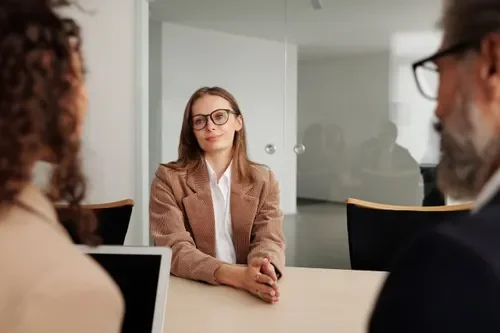What to Wear to a Job Interview in 2025 (Even If It’s on Zoom)
What to Wear to a Job Interview in 2025 (Even If It’s on Zoom)
You’ve made it to the interview. Your resume got noticed. You’re preparing your answers. And now… you're staring into your closet wondering: "What should I wear to this job interview?"
You’ve made it to the interview. Your resume got noticed. You’re preparing your answers. And now… you're staring into your closet wondering: "What should I wear to this job interview?"
In a world where job interviews can happen over video calls, in-person, or even at a café, dressing right isn’t about following outdated rules. It’s about feeling confident, showing respect, and communicating, visually, that you take this opportunity seriously.
In this guide, we’ll break down exactly what to wear for every type of interview—from formal to casual to Zoom—so you can walk (or log) in looking like the best version of yourself.
Why Your Interview Outfit Still Matters in 2025
Even in an increasingly relaxed and remote world, first impressions haven’t changed. Interviewers form an opinion within the first few seconds of seeing you—and your outfit plays a big role in that.
Your clothing says:
● “I understand the culture of this company.”
● “I prepared for this conversation.”
● “I respect your time—and mine.”
But it’s not about expensive clothes or trends. It’s about fit, comfort, and intention.
The #1 Rule: Dress One Level Up
If you’re not sure what to wear, this rule always works:
● Dress one notch more polished than the company’s everyday style.
● If employees wear jeans and t-shirts, go for smart casual: a clean shirt and well-fitting trousers or a blouse and blazer.
● If they dress business casual, lean more formal: button-down shirt, structured blazer, midi dress, or dress pants.
● If it’s a corporate environment (finance, law, etc.), stick to full business formal.
What to Wear Based on Interview Format
1. In-Person Interview (Office Setting)
Stick to classic, neat, well-fitting clothes in neutral tones. Think:
● Button-down shirt or blouse
● Slacks, pencil skirt, or structured dress
● Blazer (optional but always sharp)
● Closed-toe shoes, clean and professional
Avoid: Wrinkles, loud patterns, heavy perfumes, and overly casual items like jeans, sneakers, or hoodies—unless the company clearly has a startup or creative dress code.
2. Zoom/Video Interview
Yes, you still need to dress up—even if only from the waist up.
Focus on:
● Solid colors (avoid distracting patterns)
● Good lighting—test how your outfit looks on camera
● Groomed hair, simple accessories
● Comfortable bottoms (yes, you can wear leggings… just don’t stand up unexpectedly!)
Pro tip: Blues, teals, and earth tones look great on camera and aren’t too harsh. Avoid bright whites or neons—they can reflect light or appear fuzzy on screen.
3. Creative or Startup Interview
If you're interviewing in a creative industry (media, fashion, tech startup, design), you’ve got a bit more freedom to show your personality. Try:
● A statement blazer or scarf
● Clean sneakers or stylish flats
● Unique jewelry (nothing too flashy)
● Trendy but polished pieces that reflect your style
Example outfit: Black jeans, a tucked-in silk blouse, and a camel coat or long blazer with gold hoops.
Just make sure you still look professional, not like you’re heading to brunch.
4. Remote Interview from Home (Informal Company)
Even if the company culture is casual, you want to look like you’re showing up for something important. Try:
● Knit top or casual blazer
● Neutral-toned T-shirt layered with a cardigan
● Soft makeup or a clean shave
● Hair brushed or styled away from your face
The goal? Presentable, approachable, and calm. You’re signaling: “Even from home, I’m someone who shows up prepared.”
What Not to Wear (In Any Interview)
● Wrinkled or stained clothing
● Distracting logos or text (especially political/slogan tees)
● Anything too tight or too baggy
● Overly strong perfume or cologne
● Hats, hoodies, or overly casual loungewear
● Sunglasses or tinted glasses (unless medically necessary)
If you’re unsure, always lean professional and simple. Clean, neat, and respectful wins every time.
Bonus Tips to Feel More Confident in Your Outfit
● Try it on the day before to make sure it fits comfortably
● Sit down in your outfit—does it bunch up? Tug anywhere?
● Choose shoes you can walk confidently in
● Keep accessories minimal (one nice necklace or a classic watch)
● Iron or steam your clothes, even if they looked “okay” in the closet
● Prepare a backup outfit in case of spills, weather, or nerves
And most importantly? Pick something that makes you feel like you. When you feel good in your clothes, you’ll carry yourself with more ease and authority.
Parting Words: Dress for the Role You Want—and the Energy You Deserve
You don’t have to spend hundreds of dollars or mimic someone else’s style. The goal is simply to show the interviewer that you take the opportunity seriously—and that you’re ready to show up with confidence and care


